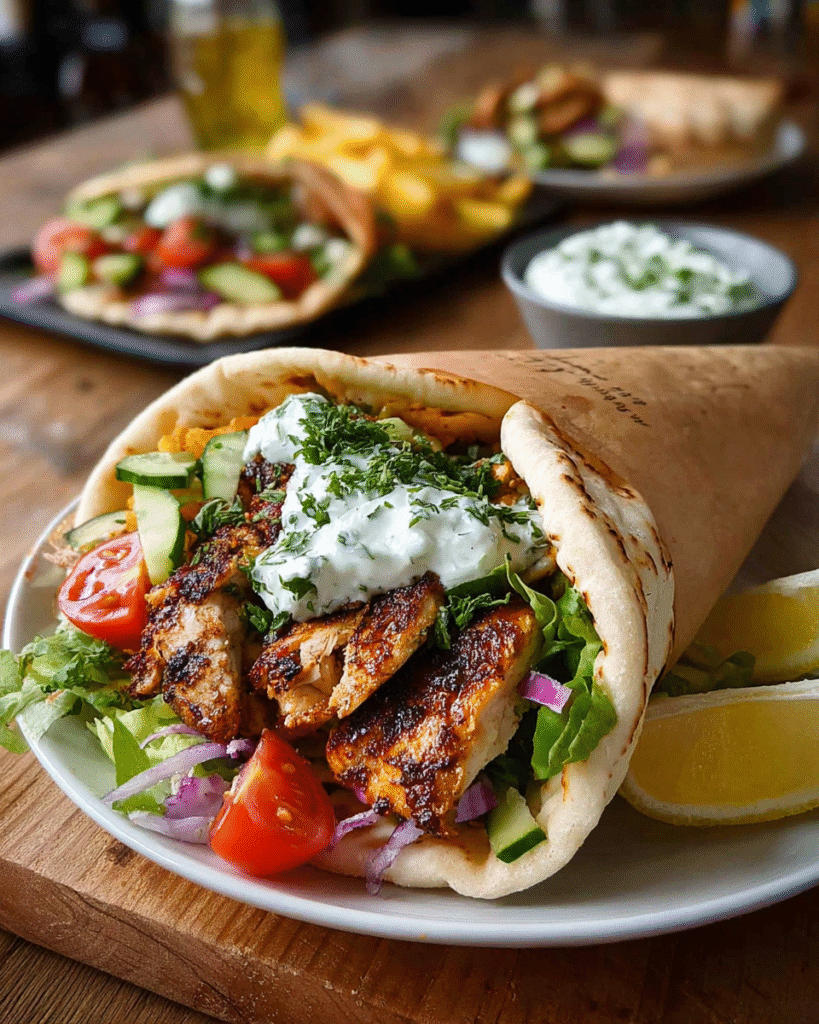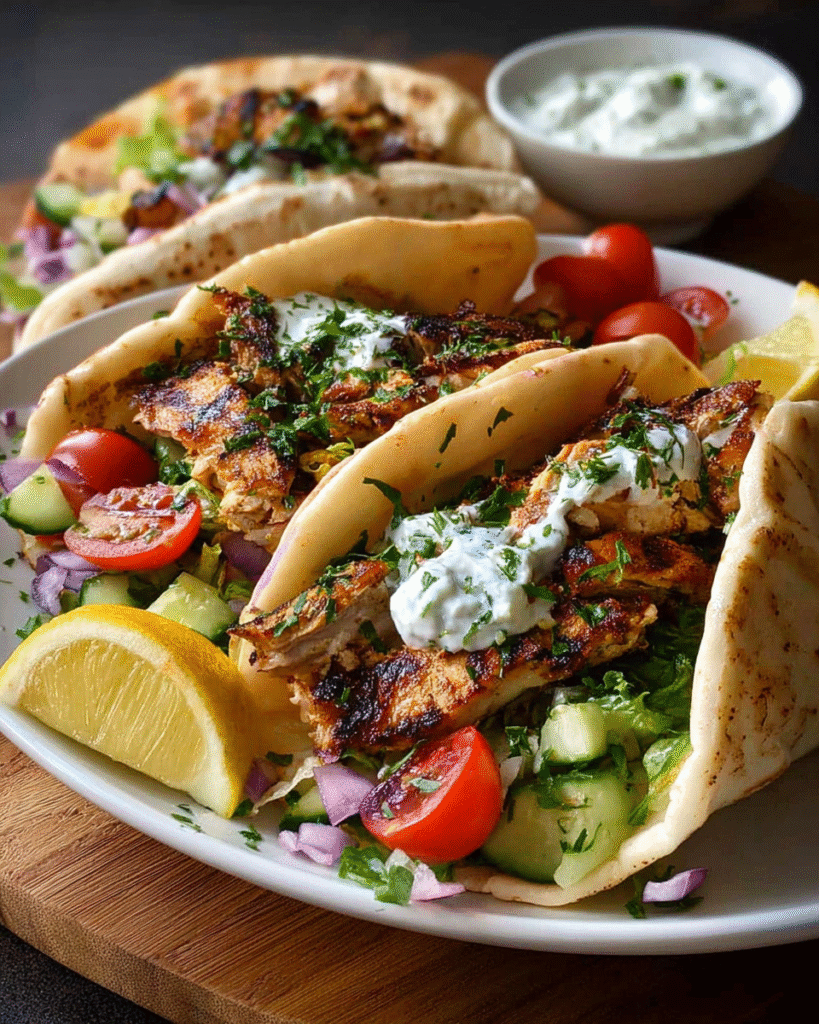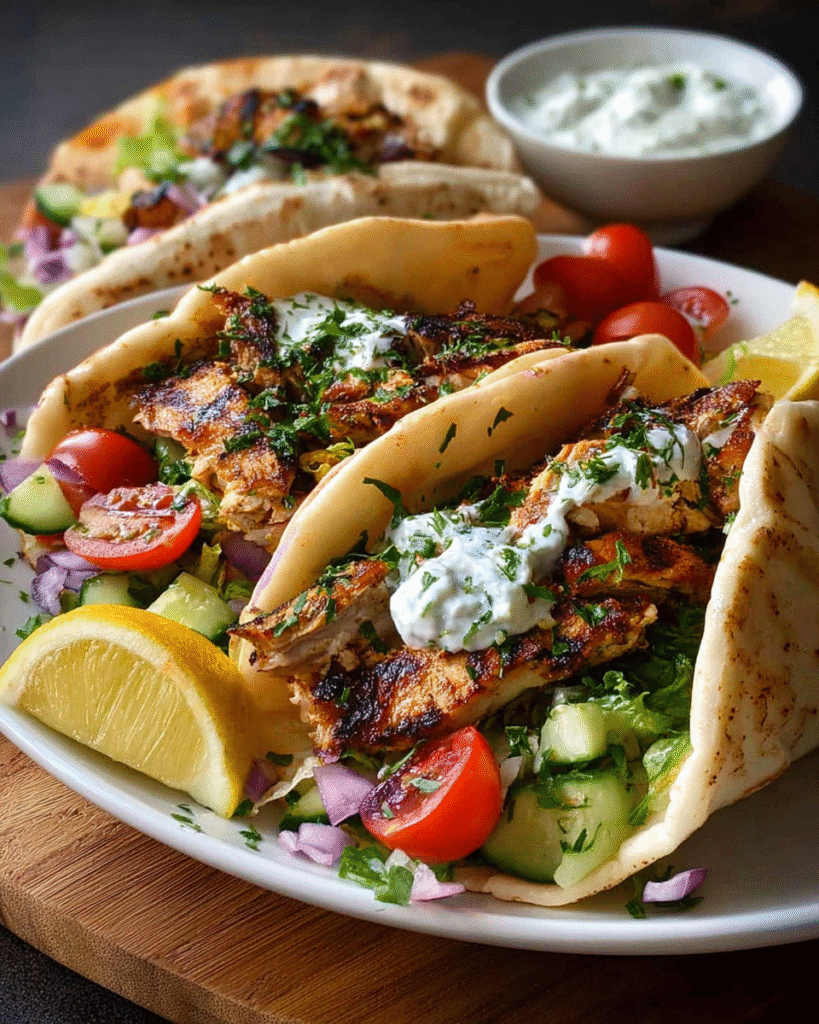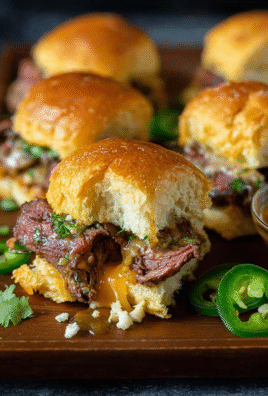
Grilled Chicken Gyro Wraps with Crisp Veggies & Creamy Yogurt Sauce are more than just a quick dinner option — they represent the perfect balance of flavor, nutrition, and tradition. Imagine tender grilled chicken marinated in olive oil, lemon juice, garlic, and aromatic herbs, tucked inside warm pita bread, then topped with crunchy fresh vegetables and a cooling yogurt sauce. The result is a handheld meal that feels both indulgent and wholesome, a Mediterranean-inspired wrap that satisfies cravings while keeping things light.
In today’s fast-paced world, recipes like this have become essential. They bring the richness of restaurant-quality dishes into home kitchens without requiring complicated techniques or hours of preparation. Gyro wraps in particular have gained popularity because they offer variety — the ability to customize with different meats, sauces, and toppings — yet still deliver a recognizable and comforting experience every time.
This guide is designed to walk you through everything you need to know about making your own chicken gyros at home. From the origins of the dish to the tools you’ll need and why this recipe stands out, Part I sets the foundation for creating wraps that are flavorful, satisfying, and easy to master.
History & Cultural Background
The word “gyro” comes from the Greek word meaning “turn” or “circle,” referring to the traditional method of preparing meat on a vertical rotisserie that slowly turns over heat. In Greece, gyros are most often made with pork, though lamb and chicken are also common. As the dish traveled beyond its homeland, variations emerged to suit different tastes and dietary preferences.
While gyros are distinctly Greek, they share a family resemblance with dishes across the Mediterranean and Middle East. Shawarma from the Levant and doner kebab from Turkey both feature seasoned meat cooked on a spit and served in bread with vegetables and sauce. These culinary cousins highlight how food traditions move and adapt across regions, each culture leaving its own mark.
The chicken gyro in particular has gained attention in modern diets for being lighter than lamb or beef versions. It appeals to those who want a healthier option without sacrificing taste. Grilling chicken instead of using a vertical rotisserie also makes it more practical for home cooks. The flavors remain robust, but the cooking method is approachable with everyday kitchen tools.
Why You’ll Love This Recipe
There are countless reasons why grilled chicken gyro wraps deserve a spot in your weekly meal rotation:
- Balanced Flavors – The smoky char of grilled chicken pairs beautifully with the refreshing tang of yogurt sauce and the crunch of raw vegetables. Every bite delivers contrast and harmony.
- Nutritious & Satisfying – Packed with lean protein, fiber from vegetables, and healthy fats from olive oil and yogurt, this meal provides energy without heaviness. It’s Mediterranean eating at its best.
- Customizable – You can adjust the spices, swap the vegetables, or even change the type of wrap to suit your preferences. From whole wheat pitas to gluten-free flatbreads, the recipe adapts easily.
- Quick & Convenient – Once the chicken is marinated, the rest comes together in minutes. It’s ideal for busy weeknights, meal prep sessions, or even casual gatherings with friends and family.
- Restaurant-Style at Home – Instead of relying on takeout, you can replicate the flavors of your favorite Mediterranean restaurant with ingredients you trust and control.
Equipment Needed
One of the most appealing aspects of this recipe is that it doesn’t require complicated or expensive equipment. With just a few essentials, you can achieve the same delicious results at home:
- Grill Pan or Outdoor Grill – Provides the smoky char and grill marks that make the chicken irresistible.
- Mixing Bowls – For preparing marinades, sauces, and keeping vegetables fresh.
- Cutting Board & Sharp Knife – Essential for chopping vegetables evenly and slicing chicken into strips.
- Skewers (Optional) – Useful if you want to thread the chicken for grilling, though not necessary.
- Kitchen Thermometer – Ensures the chicken is cooked through without becoming dry.
Even if you don’t own an outdoor grill, a simple stovetop pan or oven broiler can deliver great results. The flexibility of preparation makes this dish accessible to anyone, no matter their kitchen setup.

Ingredients in Detail
A great gyro wrap depends on the quality and balance of its ingredients. Each element adds a layer of flavor and texture that makes the wrap memorable. Let’s look closely at what you’ll need.
For the Chicken Marinade
- Chicken – Boneless, skinless chicken breasts are lean and cook quickly, but thighs provide extra juiciness and flavor. Choosing organic or free-range chicken can also enhance taste.
- Olive Oil – The backbone of Mediterranean cooking, olive oil helps tenderize the meat and adds richness.
- Lemon Juice and Zest – Provides brightness and acidity, cutting through the richness of the chicken and balancing the earthy spices.
- Garlic Cloves – A classic aromatic, garlic infuses the chicken with bold Mediterranean character.
- Greek Yogurt (Optional) – Acts as a tenderizer while adding creaminess to the marinade. It clings to the chicken, ensuring even seasoning.
- Dried Oregano and Thyme – These herbs give the dish a distinctly Greek identity. They add earthy and savory undertones that pair beautifully with grilled meat.
- Paprika and Cumin – For warmth and subtle smokiness. They complement the charred grill flavor.
- Salt and Black Pepper – Simple but necessary to bring out the flavors of all other ingredients.
For the Wrap
- Pita Bread or Flatbread – Soft, fluffy pita bread is traditional. You can also use naan, lavash, or tortillas depending on availability and preference.
- Crisp Vegetables – Tomatoes, cucumbers, lettuce, red onions, and bell peppers are classic choices. Their freshness and crunch balance the warm chicken and creamy sauce.
- Feta Cheese (Optional) – Adds a salty, tangy punch. Use sparingly if you prefer a lighter wrap.
For the Creamy Yogurt Sauce
- Greek Yogurt – Thick, tangy, and protein-packed. It forms the base of the sauce.
- Cucumber – Grated and drained to remove excess water. Adds refreshing crunch and coolness.
- Fresh Dill and Mint – Herbs that lift the sauce with freshness and brightness.
- Lemon Juice – Enhances flavor and adds tang.
- Olive Oil – Smooths out the texture and adds richness.
- Garlic – Raw garlic adds a sharp bite. Use sparingly if you want a milder sauce.
- Salt and Pepper – Essential to bring all the flavors together.
Ingredient Substitutions & Variations
One of the joys of making gyros at home is the flexibility to adapt ingredients based on dietary needs or personal preference.
- Gluten-Free – Swap pita for gluten-free flatbread or wrap the gyro in crisp lettuce leaves for a lighter, carb-free option.
- Dairy-Free – Use coconut yogurt, almond-based yogurt, or cashew cream instead of Greek yogurt. They provide similar creaminess with a slightly different flavor.
- Protein Alternatives – Lamb, beef, or turkey can be marinated in the same blend of spices. For a vegetarian or vegan version, grilled tofu, tempeh, or falafel make excellent substitutes.
- Spice Variations – Add cayenne pepper for heat, curry powder for an Indian-inspired twist, or smoked paprika for a deeper smoky flavor.
- Different Breads – Try whole wheat pita for extra fiber, or lavash for a thinner, chewier wrap. Even tortillas can work in a pinch.
Step-by-Step Preparation
1. Marinate the Chicken
- Cut the chicken into strips or cubes for faster cooking and even seasoning.
- In a bowl, whisk together olive oil, lemon juice, zest, garlic, yogurt, and spices.
- Coat the chicken thoroughly, ensuring each piece is covered.
- Cover the bowl and refrigerate for at least 30 minutes. For the best flavor, marinate for several hours or overnight.
2. Prepare the Yogurt Sauce
- Grate cucumber and squeeze out excess water using a cheesecloth or paper towel.
- Mix Greek yogurt, cucumber, dill, mint, garlic, lemon juice, olive oil, salt, and pepper.
- Chill the sauce for at least 30 minutes to allow flavors to develop.
3. Chop & Prep the Vegetables
- Slice tomatoes and cucumbers thinly for even layering.
- Red onions can be sliced into thin rings or pickled for extra tang.
- Keep vegetables chilled until ready to use for maximum crunch.
4. Cook the Chicken
- Grill Pan Method: Heat the pan over medium-high heat and cook chicken for 4–5 minutes per side until golden brown and fully cooked.
- Outdoor Grill Method: Preheat grill, place chicken directly over heat, and cook until juices run clear.
- Oven Broiler Method: Spread chicken on a lined tray and broil, turning once, until cooked through.
- Use a thermometer to confirm the internal temperature reaches 165°F (74°C).
5. Assemble the Wraps
- Warm pita bread on the grill or in a dry skillet.
- Lay chicken strips in the center.
- Top with crisp vegetables.
- Add a generous spoonful of creamy yogurt sauce.
- Fold and wrap tightly for easy eating.
Cooking Tips & Tricks
- Avoid Dry Chicken – Don’t overcook. Marinating with yogurt and olive oil helps retain moisture.
- Warm the Pita Properly – A warm, slightly charred pita is more pliable and holds the filling better.
- Balance Flavors – Keep the chicken well-seasoned, the veggies fresh, and the sauce tangy. A balance of textures and tastes makes the gyro exceptional.
- Meal Prep Strategy – Cook a large batch of chicken and store it in the fridge. It reheats well and can be used for wraps, bowls, or salads throughout the week.
- Skewers for Even Cooking – Threading chicken onto skewers ensures even cooking and easy flipping on the grill.

Serving Suggestions
A grilled chicken gyro wrap is a complete meal on its own, but the right sides and accompaniments can transform it into a feast. Pairing and presentation matter just as much as flavor, especially when you’re serving to family or guests.
- Classic Greek Side Dishes – Serve your wraps with a traditional Greek salad made of tomatoes, cucumbers, olives, red onion, and feta. Add a drizzle of olive oil and a sprinkle of oregano for authenticity. Roasted lemon potatoes or spanakopita (spinach pie) also make excellent sides.
- Dips and Spreads – Gyros love company. Hummus, baba ghanoush, or roasted red pepper dip complement the creamy yogurt sauce while giving guests options for variety.
- Light Additions – A fresh fruit salad with melon, grapes, or citrus provides a sweet, refreshing contrast.
- Drinks – Pair your wrap with iced tea, sparkling water infused with lemon and mint, or a refreshing homemade lemonade. For special occasions, a crisp white wine or sangria with citrus and berries balances the herbs and spices beautifully.
- Entertaining Idea – Create a “gyro bar” for gatherings. Set out grilled chicken, sauces, fresh veggies, and pita bread, and let guests assemble their wraps. It’s interactive, fun, and ensures everyone customizes their meal to their liking.
Nutrition Breakdown
Homemade chicken gyro wraps are a nutritious alternative to restaurant versions, which often contain more calories, sodium, and added fats. This recipe offers a balance of macronutrients and micronutrients.
- Protein – Chicken provides a high-quality source of lean protein, essential for muscle repair and energy.
- Healthy Fats – Olive oil and yogurt contribute heart-healthy fats that help with satiety and flavor.
- Carbohydrates – Pita bread or flatbread provides sustained energy, while vegetables add fiber and keep digestion healthy.
- Vitamins & Minerals – Fresh vegetables deliver vitamin C, vitamin A, potassium, and antioxidants. Herbs like dill and mint bring additional phytonutrients.
Compared to lamb or beef gyros, the chicken version is lower in saturated fat and calories while still offering plenty of taste. The yogurt sauce adds probiotics that support gut health, making the entire meal both flavorful and functional.
Common Mistakes to Avoid
Even simple recipes like gyros can go wrong without attention to detail. Here are some mistakes to avoid when preparing grilled chicken gyro wraps:
- Skipping the Marinade – Rushing the process and cooking unseasoned chicken results in bland wraps. The marinade is crucial for flavor and tenderness.
- Over-Marinating with Too Much Acid – While lemon juice is important, too much or too long can break down the meat and make it mushy.
- Not Draining the Cucumber for the Sauce – A watery yogurt sauce will soak into the pita and ruin the texture. Always squeeze out excess moisture.
- Using Cold Chicken on the Grill – Allow chicken to come to room temperature for even cooking. Cold meat can seize and dry out.
- Skipping Pita Warming – Cold or stiff pita bread cracks and tears when wrapped. Warming it makes it pliable and more enjoyable to eat.
Tips for Perfect Gyros Every Time
- Choose the Right Chicken Cut – Thighs offer more juiciness, while breasts are leaner. If possible, use a mix for the best of both worlds.
- Use Thick Yogurt – For the sauce, opt for strained Greek yogurt or drain regular yogurt to achieve the right creamy texture.
- Keep Herbs Fresh – Fresh dill, parsley, and mint elevate the flavors far beyond dried versions. Chop them just before mixing.
- Prep in Advance – Marinade, sauce, and chopped vegetables can all be prepared a day ahead, making assembly quick and stress-free.
- Serve Immediately – Assemble wraps just before serving to keep vegetables crisp and pita soft.
Storage & Make-Ahead Options
One of the best things about grilled chicken gyros is how well they fit into a meal-prep routine.
- Cooked Chicken – Store grilled chicken in an airtight container in the refrigerator for up to 4 days. Reheat in a skillet with a splash of water or olive oil to prevent dryness.
- Freezing Chicken – Marinated but uncooked chicken can be frozen for up to 3 months. Thaw overnight in the fridge before grilling. Cooked chicken can also be frozen, though texture may slightly change.
- Yogurt Sauce – Best made fresh, but it can be refrigerated for up to 3 days. Stir before serving.
- Vegetables – Chop vegetables on the day of serving for peak freshness, though tomatoes and cucumbers can be prepared a few hours ahead if kept chilled.
- Assembled Wraps – Not ideal for storage, as the bread will soften and vegetables lose crunch. Assemble only what you plan to eat immediately.
Pairing & Customization Ideas
Gyros are endlessly versatile. Here are creative ways to adapt the recipe for different needs and occasions:
- Gyro Bowls – Skip the pita and serve chicken, veggies, and sauce over rice, quinoa, or couscous.
- Kid-Friendly Sliders – Use mini pita or flatbread rounds to create smaller portions that are easier for kids to handle.
- Party Platter – Cut wraps in halves or quarters, secure with toothpicks, and serve as appetizers.
- Vegan Version – Replace chicken with grilled eggplant, zucchini, or falafel. Use dairy-free yogurt for the sauce.
- Spicy Kick – Add harissa, chili flakes, or a drizzle of hot sauce to the yogurt for extra heat.
FAQs
Can I use rotisserie chicken instead of grilling?
Yes, shredded rotisserie chicken works in a pinch. Season it lightly with oregano and lemon juice to mimic the flavor of marinated grilled chicken.
What is the best bread for gyros?
Traditional Greek pita is ideal. Look for thicker, fluffier varieties that can hold fillings without tearing. Lavash or naan can also work.
Can I make this recipe without a grill?
Absolutely. A stovetop grill pan, cast iron skillet, or oven broiler all give excellent results.
How can I make the wrap spicier or milder?
Adjust the marinade spices. Add chili powder or cayenne for heat, or reduce garlic and pepper for a milder taste.
Is this recipe freezer-friendly?
The marinated chicken freezes well, but fully assembled wraps do not. For best results, freeze uncooked marinated chicken and prepare wraps fresh.
Conclusion
Grilled Chicken Gyro Wraps with Crisp Veggies & Creamy Yogurt Sauce bring the vibrant flavors of the Mediterranean to your kitchen in a dish that is as wholesome as it is satisfying. With juicy marinated chicken, crunchy vegetables, and a refreshing yogurt sauce, these wraps deliver balance in every bite. They are versatile enough for quick weeknight dinners, meal prep, or gatherings with friends.
By understanding the cultural background, choosing quality ingredients, and following key preparation steps, you can master this recipe and enjoy it in countless variations. Whether you serve it with traditional sides, adapt it into bowls or sliders, or keep it simple with a classic wrap, this dish is sure to become a regular favorite.
Bring the grill to life, gather fresh vegetables, whisk up a creamy sauce, and assemble your perfect gyro wrap. Each bite is a reminder that great food doesn’t have to be complicated — it just needs the right balance of flavors prepared with care.




Leave a Comment